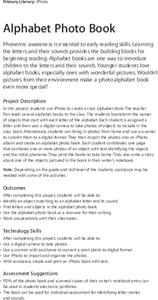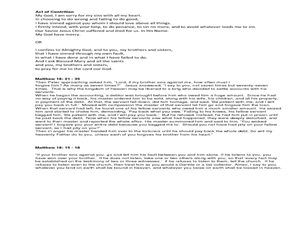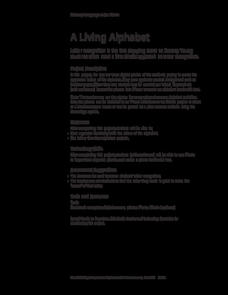Curated OER
Alphabet Photo Book
Students use iPhoto to create a class alphabet book. After the teacher reads several alphabet books to the class, students brainstorm the names of objects that start with each letter of the alphabet.
Curated OER
The Sinking of the Titanic
Investigate the sinking of the Titanic with young scholars. They will read actual documentation from the Titanic and answer questions. They will then draw conclusions from the pictures they see and information they read.
Perkins School for the Blind
Conversation Skills
It is so important for learners with multiple disabilities to learn how to communicate for both social and functional reasons. Each child will choose a topic from the list and generate five questions related to that topic. They'll split...
VH1
Lesson 4: Behind the Movie Chicago
The elements of music and journalistic integrity in one lesson; What could be better? The class discusses journalistic approaches to better understand responsible reporting versus sensationalism. They watch the Act One from the film...
Curated OER
After Reading: "Plot the Plot" Activity in the Library Media Class
"Plot the plot" of "The Adventures of the Speckled Band" with your young readers. Take a few days to read Sir Arthur Conan Doyle's short story as a class or in pairs, having learners write down what they consider to be the most important...
US National Archives
The Royal Seal What Can It Tell Us?
Analyze the images and details of the Great Seal of Queen Elizabeth I, and discover clues that reveal how one of the greatest monarchs in the history of England wished to be seen and respected. This is a great way to discuss how even to...
Perkins School for the Blind
Tactile Journals
I absolutely love this idea. Children with visual impairments create tactile journals which describe an event from the previous week in an artistic way. They verbally describe one event from the previous week and then use a wide array of...
Florida International University
Counting FishStix
How do we count the fish in the ocean? An engaging lesson models how to estimate fish populations with observational surveys. Class members begin by studying the behavior of fish on the coral reef in the oceans. They then become the fish...
Florida International University
Design Your Own
Apply scientific principles to designing an experiment to study organisms living on the coral reef in our oceans. Through reading, individuals learn about the coral reef ecosystem and important factors that affect its function. Using the...
Curated OER
Seas of Grass
High schoolers view a video clip about grasslands. They identify threats to grasslands and describe cultures which have adapted to grassland conditions. They discuss possible solutions to preserve grasslands as well.
Curated OER
The Urban Explosion
Students investigate the uncontrolled development of the world's major cities. They define key vocabulary terms, view and discuss video excerpts, and complete a project that involves drawing a "perfect city," developing a plan to...
Curated OER
Land of Plenty, Land of Want
Students view a video about the state of the environment. They discover the topic of sustainable agriculture. They identify problems and how to solve them.
Curated OER
Environment: Rivers of Destiny
Students investigate the results of human intervention with the Mekong. Mississippi, and Amazon rivers. After watching a video about the status of the three rivers, they complete experiments demonstrating the effects of erosion and...
Curated OER
On the Brink
Students view a film about environmental issues. They discover how environmental degradation can lead to disease. They identify the relationship between population growth and the environment.
Curated OER
Dealing with Disasters: Exploring a Cyclone Shelter
Students participate in reading activities to discover what a cyclone is and how cyclones affect those parts of the world that they hit. They discuss what kind of shelter would be best to create in anticipation of a cyclone.
Curated OER
Empathy and the Vietnam War
Students explore the implications of the draft during the Vietnam War. In this Vietnam lesson, students analyze the lyrics of songs that explore differents opinions of the Vietnam draft. Students particpate in a role-play activity that...
Curated OER
Reformation History: A Comparative Study
Students explore the views of Catholics, Lutherans and the Reformed Church. In this reformation instructional activity, students participate in a class discussion of the three religions, then complete an activity.
Curated OER
Conscience, Sin, and Correction
Twelfth graders consider the structure of the Roman Catholic Church in the Middle Ages. In this morality lesson, 12th graders examine the 95 Theses of Martin Luther and determine his reason for writing them. Students also discuss the...
Curated OER
Using Rock to Teach Literary Devices: Jimi Hendrix “The Wind Cries Mary”
Students explore literary elements through music. In this figurative language lesson, students examine imagery and personification in "The Wind Cries Mary" by Jimi Hendrix.
Curated OER
A Living Alphabet
Students have a greater familiarity with the letters of the alphabet and use letters for other alphabet projects..
Curated OER
British Imperialism in India
Tenth graders learn how the differences between Indian and British cultural perspectives, as seen in works of art. Students participate in discussion of the differences in how individuals are viewes by others.
Curated OER
Fabric Collage
Students practice simple hand sewing techniques to repair clothing using various stitches and techniques for sewing a button to fabric. They design and create a fabric collage that includes at least one button, two types of hand...
Curated OER
Illinois Endangered & Threatened Species
Sixth graders identify endangered and threatened species in Illinois. Using fact sheets, they explore why some species are more likely to be on the list than others. Using the internet, they research one species, note its adaptations and...
Curated OER
Fill The Bill
Students identify and describe five different types of beaks. Using that information, they explain how each of them is adapted to feed on different foods. In groups, they travel around the room to various stations in order to practice...

























